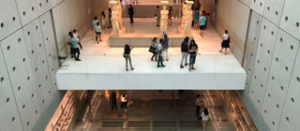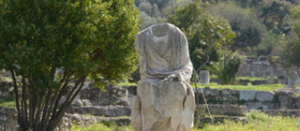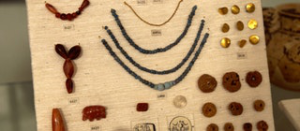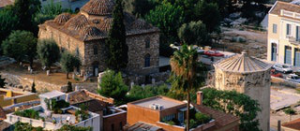Acropolis Museum
Top choice museum in Acropolis Area

Image by Vangelis Koronakis Lonely Planet
This dazzling museum at the foot of the Acropolis‘ southern slope showcases its surviving treasures. The collection covers the Archaic period to the Roman one, but the emphasis is on the Acropolis of the 5th century BC, considered the apotheosis of Greece’s artistic achievement. The museum reveals layers of history – from ancient ruins beneath the building, to the Acropolis itself, always visible above through floor-to-ceiling windows. The good-value restaurant has superb views.
Tickets & tours
Acropolis and the Acropolis Museum
$51.38
and up
Acropolis & Acropolis Museum (Morning Walking Tour)
$53.66
and up
Skip the Line Acropolis Museum Tour
$33.11
and up
Details
Dionysiou Areopagitou 15
Makrygianni
Hours8am-4pm Mon, to 8pm Tue-Thur & Sat-Sun, to 10pm Fri Apr-Oct, 9am-5pm Mon-Thu, to 10pm Fri, to 8pm Sat & Sun Nov-Mar
Priceadult/child €10/free
Designed by US-based architect Bernard Tschumi with Greek architect Michael Photiadis, the €130-million museum opened in 2009 after decades of planning; it replaced the small museum near the Parthenon.
As you enter the museum, the glass floor reveals the ruins of an ancient Athenian neighbourhood. These were uncovered during construction and had to be preserved and integrated into a new building plan. In 2019, the museum opened up a section of these ruins for closer inspection.
The ground floor’s Gallery of the Slopes of Acropolis emulates the climb up to the sacred hill, while allowing glimpses of the ruins below. Exhibits include painted vases and votive offerings from the sanctuaries where gods were worshipped, plus more recent objects found in excavations of the settlement, including two clay statues of Nike at the entrance.
Bathed in natural light, the 1st-floor Archaic Gallery is a veritable forest of statues, mostly votive offerings to Athena. These include stunning examples of 6th-century kore – statues of young women in draped clothing and elaborate braids, usually carrying a pomegranate, wreath or bird. Most were recovered from a pit on the Acropolis, where the Athenians buried them after the Battle of Salamis. The 570-BC-statue of a youth bearing a calf is one of the rare male statues found. There are also bronze figurines and artefacts from temples predating the Parthenon (destroyed by the Persians), including wonderful pedimental sculptures such as Hercules slaying the Lernaian Hydra and a lioness devouring a bull. Also on this floor are five Caryatids, the maiden columns that held up the Erechtheion (the sixth is in the British Museum).
The museum’s crowning glory is the top-floor Parthenon Gallery, a glass atrium housing the temple’s 160m-long frieze. It’s mounted as it once was, following the layout of the building, and you can stroll along, as though atop the columns, and examine the fragments at eye level. The frieze depicts the Panathenaic Procession, starting at the southwest corner of the temple, with two groups splitting off and meeting on the east side for the delivery of the peplos (shawl) to Athena. (To really understand the reliefs, see the film that is screened on this floor.) Interspersed between the golden-hued originals are stark-white plaster replicas of the missing pieces – the so-called Parthenon Marbles hacked off by Lord Elgin in 1801 and now held in the British Museum in London.
Also on this level are metopes and sculpture from the Parthenon, as well as a plaster replica of a giant floral akrotirion, a decorative element that once crowned the southern ridge of the pediment.
Parthenon
Top choice temple in Acropolis Area
Designed to be the pre-eminent monument of the Acropolis, the Parthenon epitomises the glory of Ancient Greece. Meaning ‘virgin’s apartment’, it’s dedicated to Athena Parthenos, the goddess embodying the power and prestige of the city. The largest Doric temple ever completed in Greece, the Parthenon took 15 years to build.
Tickets & tours
Athens Private Tour with Acropolis, Parthenon, Plaka, Thision
$49.10
and up
Athens 4-Hour Guided Private Tour with Acropolis, Parthenon
$102.76
and up
Athens City Tour with Acropolis, Parthenon, Plus Cape Sounion
$135.64
and up
It was designed by Iktinos and Kallicrates and completed in time for the Great Panathenaic Festival of 438 BC.
Built on its highest ground of the Acropolis, the Parthenon had a dual purpose: to house the great statue of Athena commissioned by Pericles and to serve as the new treasury. It was built on the site of at least three earlier temples dedicated to Athena.
The temple consisted of eight fluted Doric columns at either end and 17 on each side. To achieve perfect form, its lines were ingeniously curved to create an optical illusion – the foundations are slightly concave and the columns are slightly convex to make both look straight. Supervised by Pheidias, sculptors worked on the architectural detail of the Parthenon, including the pediments and friezes, which were brightly coloured and gilded.
The metopes (the decorative panels on the temple’s exterior) on the eastern side depicted the Olympian gods fighting the giants; on the western side they showed Theseus leading the Athenian youths into battle against the Amazons. The southern metopes illustrated the contest of the Lapiths and Centaurs at a marriage feast, while the northern ones depicted the sacking of Troy.
Much of the frieze inside depicting the Panathenaic Procession was damaged in a devastating 1687 gunpowder explosion – the Turks had been storing ammunition here; the Venetians launched a mortar at it. Earlier, Christians had defaced some of the pieces, too. But the greatest existing part (over 75m long) consists of the controversial Parthenon Marbles, taken by Lord Elgin and now in the British Museum in London. The British government continues to ignore campaigns for their return.
The ceiling of the Parthenon, like that of the Propylaia, was painted blue and gilded with stars. At the eastern end was the holy cella (inner room of a temple), into which only a few privileged initiates could enter. Here stood the statue for which the temple was built: the Athena Parthenos (Athena the Virgin), considered one of the wonders of the ancient world. Designed by Pheidias and completed in 432 BC, it was made of gold and ivory with a wooden core and stood almost 12m high on its pedestal. The face, hands and feet were made of ivory, and the eyes were fashioned from jewels. Clad in a long gold dress with the head of Medusa carved in ivory on her breast, the goddess held a statuette of Nike (the goddess of victory) in her right hand; in her left, a spear with a serpent at its base. On top of her helmet was a sphinx, with griffins in relief at either side.
In AD 426 the statue was taken to Constantinople, where it disappeared. There’s a small Roman copy (the Athena Varvakeion) in the National Archaeological Museum.

This lush, tranquil site is named for the potters who settled it around 3000 BC. It was used as a cemetery through the 6th century AD. The grave markers give a sense of ancient life; numerous marble stelae (grave markers) are carved with vivid portraits and familiar scenes.
Tickets & tours
Segway Tour in Ancient Athens, Agora and Keramikos
$67.36
and up
Private Athens Night Out in Monastiraki, Keramikos and Gazi
$43.39
and up
Kos Island Private Tour: Zia, Asklepieion, Wine Tasting
$105.04
and up
Details
Ermou 148
Keramikos
Hours8am-8pm, reduced hours in low season
Priceadult/child incl museum €8/free
The site was uncovered in 1861 during the construction of Pireos St; it once sat on the clay-rich banks of the Iridanos River.
There’s an excellent small museum here.
Once inside, head for the small knoll ahead to the right, where you’ll find a plan of the site. A path leads down to the right from the knoll to the remains of the city wall built by Themistocles in 479 BC, and rebuilt by Konon in 394 BC. The wall is broken by the foundations of two gates; tiny signs mark each one.
The first, the Sacred Gate, was where pilgrims from Eleusis entered the city during the annual Eleusian procession. The gate marked the end of the Sacred Way, aka Iera Odos, which is now a wide city street that still follows a straight route west to Elefsina. To the northeast are the remains of the Dipylon Gate – the city’s main entrance and where the Panathenaic Procession began. It was also where the city’s prostitutes gathered to offer their services to travellers. From a platform outside the Dipylon Gate, Pericles gave his famous speech extolling the virtues of Athens and honouring those who died in the first year of the Peloponnesian Wars.
Between the Sacred and Dipylon Gates are the foundations of the Pompeion, used as a dressing room for participants in the Panathenaic Procession.
Leading off the Sacred Way to the left as you head away from the city is the Street of Tombs. This avenue was reserved for the graves of Athens’ elite, while ordinary citizens were buried in surrounding areas. The surviving stelae are now in the site museum or the National Archaeological Museum, so what you see are mostly replicas. The astonishing array of funerary monuments and their bas-reliefs warrant close examination. One well-preserved stela (up the stone steps on the northern side) shows a little girl with her pet dog. The site’s largest stela is of sisters Demetria and Pamphile.
Ancient Agora
Top choice historic site in Monastiraki & Psyrri

Image by Marissa Tejada Lonely Planet
The Agora was ancient Athens’ heart, the lively hub of administrative, commercial, political and social activity. Socrates expounded his philosophy here; in AD 49 St Paul came here to win converts to Christianity. The site today is a lush respite, home to the grand Temple of Hephaistos, a good museum and the late-10th-century Byzantine Church of the Holy Apostles, trimmed in brick patterns that mimic Arabic calligraphy. The greenery harbours birds and lizards. Allow about two hours to see everything.
Tickets & tours
Play & Learn in the Ancient Agora of Athens
$274.22
and up
Skip the Line Ancient Agora and the Agora Museum Tour
$33.11
and up
Segway Tour in Ancient Athens, Agora and Keramikos
$67.36
and up
Details
Adrianou 24
Monastiraki
Hours8am-8pm Apr-Oct, to 3pm Nov-Mar
Priceadult/student/child €8/4/free
First developed as a public site in the 6th century BC, the Agora was devastated by the Persians in 480 BC, but a new one was built in its place almost immediately. It was flourishing by Pericles’ time and continued to do so until AD 267, when it was destroyed by the Herulians, a Gothic tribe from Scandinavia. The Turks built a residential quarter on the site, but this was demolished by archaeologists after Independence and later excavated to Classical and, in parts, Neolithic levels.
Admission to the site is included with the Acropolis combo ticket (€30), which permits entry to the Acropolis and six other sites (including this one) within five days.

Housing the world’s finest collection of Greek antiquities in an enormous neoclassical building, this museum is one of Athens’ top attractions. Treasures offering a view of Greek art and history – dating from the Neolithic era to Classical periods, including the Ptolemaic era in Egypt – include exquisite sculptures, pottery, jewellery, frescoes and artefacts found throughout Greece. The beautifully presented exhibits are displayed mainly thematically.
Tickets & tours
Athens National Archaeological Museum Private Tour
$85.63
and up
Private Walking Tour: National Archaeological Museum
$58.23
and up
Athens National Archaeological Museum Private Shore Excursion
$75.20
and up
Details
Patision 44
Exarhia
Hours8am-8pm Wed-Mon, 12.30am-8pm Tue mid Apr-Oct, reduced hours Nov-mid Apr
Priceadult/child €10/free mid Apr-Oct; €5/free Nov-mid Apr
It could take several visits to appreciate the museum’s vast holdings, but it’s possible to see the highlights in a couple of hours. The museum also hosts world-class temporary exhibitions.
A joint ticket with the neighbouring Epigraphical Museum, the Byzantine & Christian Museum and the Numismatic Museum costs €15 (€8 for students) and is valid for three days.
Roman Agora
Top choice historic site in Monastiraki & Psyrri

This was the city’s market area under Roman rule, and it occupied a much larger area than the current site borders. You can see a lot from outside the fence, but it’s worth going in for a closer look at the well-preserved Gate of Athena Archegetis, the propylaeum (entrance gate) to the market, as well as an Ottoman mosque and the ingenious and beautiful Tower of the Winds, on the east side of the site.
Tickets & tours
Romantic Athens
$54.80
and up
Romantic Dinner with Acropolis View
$87.91
and up
Romantic Hydra Private Day Excursion
$210.08
and up
Details
Dioskouron
Monastiraki
Hours8am-3pm Mon-Fri, to 5pm Sat & Sun, mosque from 10am
Priceadult/student/child €6/3/free
The gate, formed by four Doric columns, was financed by Julius Caesar and erected sometime during 10 BC. To the right of the entry, look also for the outlines of what was a 68-seat public latrine. Squatting atop one wing of the agora is the 17th-century Fethiye Mosque, now restored and housing temporary exhibitions. The mosque interior frescoes have been lost – except for a tiny patch high on the back wall.
Admission to the site is included with the Acropolis combo ticket (€30), which permits entry to the Acropolis and six other sites (including this one) within five days.
